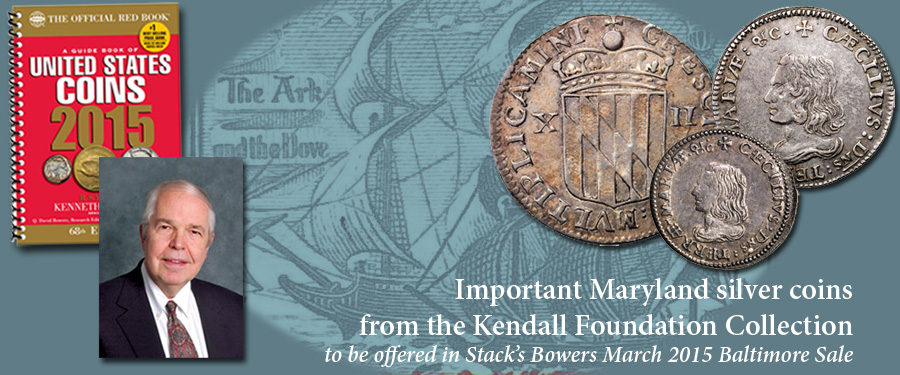
I continue my tour of A Guide Book of United States Coins, based on the 2015 edition. You can follow along by turning to page 39 of that text. In addition to what is in that familiar red-covered book, I give other details. This part of the tour will focus on the silver coins of Maryland.
On June 20, 1632, Cecil Calvert, the second Lord Baltimore, received from King Charles of England a grant for a new province in America named for the queen, Mary, and designated as Terra Marie, or Mary’s Land, familiarly Maryland. In this era and later, patents or privileges were granted by the British crown for various entrepreneurial adventures, including settling in America, engaging in the slave trade, maritime commerce and more. For the Maryland privilege the king was to receive as royalty one-fifth of the gold and silver that might be found there, plus a yearly tribute of two Indian arrows. As it turned out, Maryland never became important in the mining or finding of precious metals.
On November 22, 1633, the Ark and the Dove left the Isle of Wight, off the coast of England, and set sail for America, arriving on February 24, 1634. Settlers arrived, and commerce, including agriculture and the raising of tobacco took place. Coined money was scarce, even rare, and trade took place using the barter system as well as such products as corn, animal pelts, wampum, gunpowder and shot, each of which was assigned a specific value that changed over time. Calvert lost control during the early part of the Commonwealth in England, but regained it in November 1657. Not long after he envisioned a coinage for the colony, to be struck at the Royal Mint in London.
After extensive correspondence, without definite legal authority, coinage commenced. Four denominations were made: the copper denarium (penny), the silver fourpence (groat), the silver sixpence, and the silver shilling. These were duly brought to America. On April 12, 1662, an act was passed to encourage the circulation of such coins, specifying that every householder and freeman in the province should take 10 shillings per poll for every taxable under their charge and custody, this being exchanged for casks of tobacco valued at twopence per pound. This arrangement was to be paid by each family over a period of three years. Much numismatic research has been done concerning has been done concerning Maryland coinage, including S.F. Streeter’s “Sketch of the Early Currency in Maryland and Virginia,” a paper read before the Historical Society of Maryland and published in The Historical Magazine, Volume II, page 42, in 1858. Sylvester S. Crosby’s Early Coins of America of 1875 had additional information, supplemented by modern scholarship in various publications, notably by Louis E. Jordan in “Lord Baltimore Coinage and Daily Exchange in Early Maryland,” in The Colonial Newsletter, August-December, 2004.
Returning to the exchange of tobacco for coins, Streeter estimated that there were 5,500 taxable persons in Maryland at the time, while Jordan could locate no specific records for 1662, but found that in 1683 there were 2,873 taxables. If the coinage equaled the amount needed in exchange, this came to £1,436, 10 shillings in silver. As is true of much early coinage, facts are scarce, and research is built on information from scattered sources.
Today all Maryland silver coins are rare, with the sixpence being the most available, although a well-worn example still costs several thousand dollars or more, and those in VF grade, $10,000 upward. Shillings are scarcer yet, with well-worn pieces bringing several thousand dollars and a VF coin $15,000 to $20,000 or more. Prices of colonial coins are hardly standard, as they trade infrequently and, beyond that, there are many variations in strike, eye appeal, and other factors. Scarcest by far is the fourpence or groat, for which a well-worn specimen will cost $5,000 or more and a VF coin $25,000 upward, if you can find one.
When I first became interested in colonial coins as a youngster in the 1950s, the copper penny or denarium was mostly viewed as a pattern, a coin made in small quantities that did not circulate. However, in recent years metal detectorists have found some buried in the earth, indicating that they did indeed pass as money in America. The number known is believed to be fewer than 10 pieces. For most numismatists the Maryland coinages are beyond easy reach. A full set, including a nice example of the denarium, would cost well over $100,000. A placeholder or alternate can be found in the form of a struck copy of the denarium, commissioned by Philadelphia dealer William K. Idler in 1860, and struck from dies by local medalist Robert Lovett, Jr. Mint State examples sell for several hundred dollars each and trade frequently.
I will see you next week. The subject will be the Saint Patrick’s or Mark Newby coinage of New Jersey.





